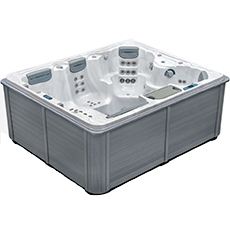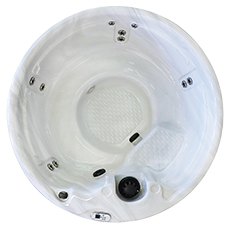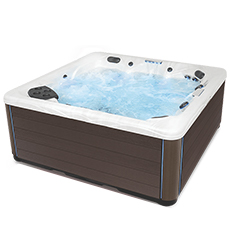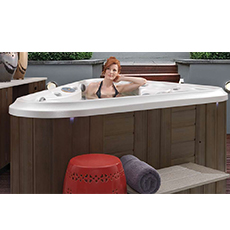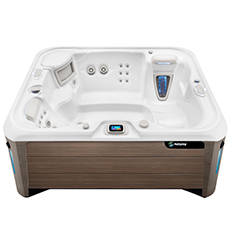Best Hot Tub Brands
The hot tub industry has several major players and is a competitive market. Our research team vetted 12 hot tub companies that are rated by more than 2,890 customers. Read our guide to choose the best hot tub by comparing prices, spa features, warranties and customer experiences.
- Our recommendations are based on what reviewers say.
- 4,337,775 reviews on ConsumerAffairs are verified.
- We require contact information to ensure our reviewers are real.
- We use intelligent software that helps us maintain the integrity of reviews.
- Our moderators read all reviews to verify quality and helpfulness.
Compare Top Hot Tub Reviews | ||||||
|---|---|---|---|---|---|---|
Compare
| Design your hot tub or select by model and seating capacity. Customizes colors, jets and accessories. Thermoinsulation system locks in heat. 20-year limited warranty. Offers financing. Prices start around $4,000. |  | Get a Quote | |||
Compare
| Features high-flow therapy, water management systems, Microsilk and standard full-cabinet foam insulation. Provides customizable lighting, audio and waterfall options. Includes owner’s protection plan. Prices start around $3,895. | |||||
Compare
| Offers hydromassage therapy features, exclusive jet technology and a variety of seating options. Provides shell or full-cabinet foam insulation. Includes lifetime warranty on select components. Prices start around $3,000. |  | ||||
Sells spas, portable hot tubs and swim spas. Features biomagnetic therapy, filtration, water management systems and energy-efficient insulation. Includes 10-year warranty on shell. Prices start at around $6,000. | Chat with a ConsumerAffairs decision guide Live agent | |||||
Manufactures luxury hot tubs. Features control panels, accent jets and therapy pillows. Offers some nonchlorine sanitation systems. Includes a five-year warranty on equipment, plumbing and cabinet. Prices start around $4,000. |  | Chat with a ConsumerAffairs decision guide Live agent | ||||
Create a customized ambiance with LED illumination, waterfalls and entertainment systems. Insulated with full-cabinet foam. Offers FreshWater Salt Systems. Includes a 10-year structural warranty. Prices start around $3,000. | Chat with a ConsumerAffairs decision guide Live agent | |||||
Sells a variety of hot tubs and hot tub accessories. Jets provide full neck and back coverage. Maximizes the benefit of hydromassage with ergonomic seats and headrest. Tub warranties vary by model. Prices start around $4,000. |  | Chat with a ConsumerAffairs decision guide Live agent | ||||
What to look for in a hot tub
If you want a good hot tub that will last for years, look for tubs made with sturdy components both inside and out. Pay attention to the different seating, jet and ambiance features that you like most as you compare models.
- Quality materials and insulation
- Most hot tubs are made of acrylic, polyethylene, vinyl or other types of plastic. Generally, acrylic and rotomolded hot tubs are popular because of their durability. Vinyl hot tubs are often cheaper but can be of lesser quality.
Remember, the cabinet of your hot tub is the part that everyone sees. Older and vintage-inspired hot tubs are sometimes made from wood like cedar, redwood, teak or recycled metal. Less commonly, you find tubs made of fiberglass or stainless steel. We suggest looking for an exterior cabinet constructed from weatherproof or UV-resistant materials.
The most common types of hot tub insulation are barrier, partial and full foam insulation. Some experts suggest you avoid spray foam insulation because it can quickly become waterlogged. No matter the style, quality hot tub insulation is important because it keeps the tub running efficiently and protects many of the major components. Investing in sturdier materials now could save you time and money on maintenance in the future.
- Effective water filtration and sanitation system
- Hot tub filters are crucial to the efficiency of your hot tub and work to keep all its systems running smoothly. Filtration captures the visible debris floating on the water's surface, and water purification gets rid of microorganisms not seen with the naked eye. Suction-type filter systems are popular because they're easy to access. A suction filter is mounted on the tub’s side and sucks water through the pump, jets and heater.
Many premium hot tubs use pressure-type filter systems — they're most effective. Pressure filtration systems fit inside the tub or pump. Cartridge filters, usually made from polyester, are a popular choice for pressure filtration systems because they're easy to maintain. We suggest avoiding filters made of cotton or paper blends because they must be replaced frequently.
Hot tub sanitation systems purify water and kill bacteria. Conventional purification systems use ozone, saltwater and UV light to disinfect the water. Some hot tub purification systems require specific chemicals (chlorine or bromine, for example) to run correctly. Saltwater hot tub systems are great for those who want to avoid harsh chemicals.
- Ozone system: Ozone works in combination with chlorine and bromine to kill germs and bacteria. It also breaks down residue from soap, shampoo and makeup that finds its way into the water. Ozone systems are generally good for small hot tubs. They're easy to install and reduce the risk of common skin conditions, but they can also make your hot tub water more corrosive.
- UV-C system: A relatively new addition to the hot tub filtration market, this method uses a high-intensity UV light ray to kill germs. Hot tubs with UV-C systems oxidize water to reduce the amount of bromine and chlorine in your tub. UV-C systems work best when used in combination with an ozonator.
- Salt system: Salt systems kill germs with naturally produced chlorine. Many people prefer this method over adding chlorine or bromine tablets to the water and say the water feels softer and silkier with a salt system. Saltwater hot tub systems are often a good alternative for those who prefer natural cleaners over chemical solutions. Hot tub saltwater systems require less maintenance because they automatically generate sanitizers as needed.
- Hot tub seating options
- Whether you plan to use your hot tub for entertainment, therapy or relaxation, you want a seating style that meets your needs.
- Barrier-free seats: Barrier-free seating provides seating without obstacles. You can easily move from one part of the spa to the other.
- Contoured seats: Contoured seats include armrests, neck rests and massage support.
- Bench seats: With bench seating, the hot tub usually has one contoured seat with bench seating around it.
- Lounge seats: Lounge seats are perfect for those seeking a relaxing experience. Ergonomically designed seats fit every contour of your body to provide therapeutic comfort. This type of seating allows you to lie nearly horizontal in the water, which creates an almost weightless feeling.
- Pivot seats: Pivot seats allow you to change position and adjust the type of hydrotherapy massage you receive.
- Therapeutic comfort seats: These seats provide extra massage points, usually at the neck, back and shoulders. Some companies offer deep-soak seats that put you as low as you can go to provide relief to your neck and spine.
- Cool-down seats: Cool-down seats let your body remain partly out of the water. Besides being the coolest part of the hot tub, these are good for transitions in and out of the tub and usually provide leg, ankle and foot massage jets.
- Massaging spa jets
- The number of jets and their placement in a hot tub play a significant part in your overall hot tub experience. Your ideal tub could feature a combination of strategically positioned jet types that provide the therapy you want, such as pressure point jets for an acupressure-like massage. Some of the most common types of hot tub jets include:
- Rotary jets: Rotary jets move water in a circular pattern.
- Pressure point jets: Pressure point jets provide acupressure-like massage to relieve discomfort and strain.
- Directional jets: Directional jets can be adjusted to point in any direction.
- Kneading oscillator jets: Kneading oscillator jets provide kneading, a therapeutic and relaxing action.
- Pulsator jets: Pulsator jets have two or more holes that alternate water pressure.
- Shower jets: Shower jets provide a gentle stream of relaxing pressure.
- Cluster jets: Cluster jets, also called ozone jets, send water flow through an open center section.
- Target therapy jets: Target therapy jets can be adjusted to relax key tension points, such as the calves or lower back. For example, foot massage therapy jets provide a pulsing hydrotherapy massage to the soles of your feet.
- Lighting and sound for ambiance
- Most modern hot tubs let you control the heater components, pumps, lights and other features through a built-in control panel. However, not all have Wi-Fi capabilities or connect to your phone. Popular hot tub features include sound systems with Bluetooth speakers and a waterfall fountain.
- Sound system: Hot tubs can be equipped with a sound system. Generally, the speakers are built into the top lip, near the headrests, and they can often be controlled wirelessly with Bluetooth.
- Decorative lighting: LED light strips can add to the ambiance and increase safety. Lighting can change the mood from soft and relaxing to exciting and energetic. You can place lights above or below the water or around the rim of the tub.
- Hot tub speakers: Speakers designed for hot tubs are waterproof and can float or fit in a cup holder. Hot tub speakers easily connect to your devices through Wi-Fi or Bluetooth so you can listen to music, podcasts and more.
Our picks for hot tub models
We started with a list of the 12 hot tub brands above. To narrow it down, we excluded companies with fewer than 100 total verified reviews on our site. We then ranked the remaining companies by overall satisfaction rating. Once we determined our picks for the top five brands, the ConsumerAffairs research team compared models and picked one favorite for each.
Our pick for ThermoSpas |
|
|
The Park Avenue comes with all the standard features you expect from top hot tub brands, and there are plenty of options for upgrades. The ozone filtration package is a great add-on for those who plan to use the tub every day because it cuts back on the amount of chemicals needed. You can also find deluxe LED lighting packages and personal jet controls.
Heaters on the Park Avenue are made with titanium components, which are supposed to last longer than other materials. We also like that it has dual therapy seats on opposite sides and a deep footwell, plus pillow jets for neck and shoulder relief.
The tub is made with a continuous-cast acrylic shell and includes a full insulation system, high-output filtration and a two-pound density cover. The spa comes in five shell colors, with four choices for cabinets.
ThermoSpas warranty information
For this model, ThermoSpas provides a 20-year structural warranty and a 10-year warranty for the shell surface. Electronics and equipment replacements are also covered for 10 years. There's also a three-year warranty on the cabinet.
Our pick for Cal Spas |
|
|
Cal Spas reviews over the last year suggest that customers are happy with the quality of their tubs and their value and style. We like that the Patio Series is made with a patented seven-layer laminate system, reinforced with steel and wood for a strong shell.
Standard features include 10 adjustable stainless steel jets and one turbo whirlpool jet, Bluetooth speakers, LED lighting, and an electronic control panel. This model comes with a 5.5-kW titanium WhisperHot heating system. The Pure Silk water purification system is also available.
Patio Round hot tubs come with a plug-and-play cord, which makes them easy to set up. The shell comes in white or silver, with more options available through the deluxe color upgrade package. The cover comes in gray or brown.
Cal Spas warranty information
Cal Spas provides a five-year structural warranty for hot tubs. The Patio Round comes with a two-year warranty on the finish. Parts and labor are also covered by a two-year warranty. The cabinet warranty is only for one year.
Our pick for Master Spas |
|
|
Some of the happiest Master Spas customers praise the Twilight Series for its water therapy benefits. The TS 8.25 comes with the Master Force biomagnetic therapy system and stress relief neck and shoulder seat. It features LED lighting, with options for Wi-Fi controls, a sound system and quiet flow pumps.
EcoPur Charge water filtration is standard, and you can upgrade to the company’s trademarked water management system, Mast3rPur, which uses ozone, UV light and filtration to sanitize the hot tub. The optional QuietFlo Water Care System filters and circulates water when the spa isn't in use, keeping it clean and warm for when you want to use it.
You can choose from three shell colors and five skirt colors. Positive reviews also note that Master Spas installers are courteous and professional.
Master Spas warranty information
Master Spas provides a 10-year structural warranty and a five-year warranty on the shell surface. Equipment, plumbing and jets are covered by a three-year warranty. There’s a five-year warranty on the DreamStone skirting and a lifetime guarantee for DuraMaster Polymer skirting.
Our pick for Marquis Spas |
|
|
Marquis is one of the most recommended hot tub brands on our site. We like that the Rendezvous Discovery’s corner design makes it easy to install in small spaces, like a deck or patio. It comes with a waterfall fountain and Bluetooth-enabled speakers. The jets are positioned to target your lower, middle and upper back, plus your feet and neck.
Its low-maintenance sanitation system incorporates smart software to automatically clean the water after a soak. The tub comes with a 120-volt plug, but you can choose to upgrade to 240 volts for a higher flow rate.
This model is available in four different shell colors and features an upgraded, durable cabinet material. It's the only one in the Celebrity series available with ash and espresso choices for the cabinet. However, due to this model’s high demand, availability may be limited in your area.
Marquis Spas warranty information
All Marquis Celebrity series hot tubs come with warranties to cover the structure for five years, the plumbing and equipment for two years and the nonwear components for one year.
Our pick for Hot Spring Spas |
|
|
We like that Triumph by Hot Spring is salt-system ready, meets California Energy Commission efficiency standards and packs serious massage power. The tub comes with 27 jets total, including 18 directional hydromassage jets. Hydrostream jets provide a constant powerful flow, and directional massage jets are easy to adjust for targeted relief.
Triumph also features the Hot Spring exclusive Moto-Massage DX jet, which sweeps up and down to target your back. Plus, precision jets work together in a cluster to target the back, neck and calves.
Hot Spring includes a wireless control panel and cover. The cabinet comes in six colors, and there are five color options for the shell. Optional features include sound systems, cover lifters and steps.
Hot Spring warranty information
Like other hot tubs in the Highlife series, Hot Springs provides a seven-year warranty on the shell surface and five-year coverage on plumbing, heaters and cabinets. There’s a two-year warranty on light assembly and a year of coverage on the wireless remote control battery.
How to buy a hot tub
- 1. Figure out your budget.
- Upfront costs to install a hard-shell hot tub range anywhere from $2,000 to $18,000. If your budget is under $2,000, start by looking online for portable and inflatable tubs (sometimes referred to as soft tubs).
Bargain hot tubs are cheaper in price, but energy-efficient models are a better investment because they're less expensive to run and require less ongoing maintenance. If you plan to enjoy the tub for many years, paying a little more upfront might be worth it to you. For more information, read about hot tub costs.
Keep in mind that you can negotiate hot tub prices — the first price you see online or in a showroom isn’t always the best you can get. Dealers also offer financing specials and promotions, such as 0% financing or low interest rates. Additional low-cost options include purchasing a used or refurbished hot tub, though doing this requires a bit more research and caution to ensure you’re getting a legitimate product.
Don’t forget to factor in ongoing costs, such as chemicals and maintenance, to your budget. Typically, it costs around $1 a day to operate a hot tub. Some of the new energy-efficient hot tubs only cost about $20 per month to run.
- 2. Decide what size and features you want.
- Choose the size of your hot tub based on the number of people who will use it. Large hot tubs are better for entertaining, but smaller tubs are better for relaxing or intimate experiences.
Hot tubs designed to accommodate two to three people are considered small. Most small hot tubs are approximately 3 feet high, 6 feet wide and 5 feet long and hold about 300 gallons of water. Large hot tubs, which can fit up to eight people or more, are usually about 4.5 feet high with a diameter of 6 feet and hold up to 850 gallons of water.
Consider which hot tub benefits are most important to you when choosing features. For example, hydrotherapy massage jets are great for reducing pain and inflammation. If you’re more interested in entertainment, look into LED lighting packages, stereo setups and lounge seating.
Different hot tub styles can complement the environment and set the tone for bathers. For instance, exterior cabinets (the part that everybody sees) are available in a variety of materials, colors, patterns and textures. Remember, a hot tub is meant to be a seamless addition to your home decor, and the style and design of the shell and cabinet should reflect your personality and aesthetic.
- 3. Compare hot tub models and reviews.
- As with most big purchases, it’s smart to make a list of three or four brands that appeal to you. Make notes of options that stand out, such as particular cabinet designs, styles of jets or seating arrangements.
Once you have your short list, you can learn a lot by reading reviews. Look out for red flags related to installation, warranty or customer service. With a hot tub, you don’t usually have to communicate with customer service unless something goes wrong.
To get the best deal, you should compare prices from multiple dealers and keep an eye out for promotional discounts. Retailers typically host sales each season, so you might wait to see if the price on a particular model you like goes down. You can also sometimes find great hot tub deals at state fairs or home and garden shows.
Look for companies that offer a warranty in case something goes wrong. It’s even better to try it before you buy it. If possible, visit a hot tub showroom and schedule a test soak.
- 4. Complete hot tub installation.
- Most hot tubs are designed to “plug and play,” meaning they're very easy to get up and running. Above-ground hot tubs are commonly placed on a concrete slab or reinforced deck. The location you select just needs to have enough structural strength to support the tub when full of water and people.
It’s a good idea to decide where you want the tub to go before the delivery day. When picking a spot, consider your comfort and convenience. For instance, those who live in an area with cold, snowy winters should try to put the spa close to a door for easy access. If you have long stretches of warm months, under a gazebo might be a better place.
If your tub is going to be installed by a professional, here are a few tips to make the process a little bit easier:
- Check the width of sidewalks, doors or gates that could cause obstruction.
- Check for overhead issues, including rain gutters or overhanging branches.
- Remove obstacles like plants, outdoor furniture or outdoor grills.
You might also need electrical access, depending on how much voltage the tub requires. Check your local building codes and zoning laws to be sure they allow for the installation of hot tubs without a permit.
- 5. Shop hot tub accessories and upgrades.
- Picking the right hot tub is only half the game — the other half includes outfitting the tub with the right accessories and safety measures for guests. Accessories like covers, spa pillows and steps improve the functionality and appearance of your hot tub. Accessories can be purchased at any time, so you don’t have to get everything all at once.
- Hot tub cover: Hot tubs usually come with a standard cover, but for tubs that are left unattended for long periods, such as those in a second home, a coverall can significantly increase the life of the hot tub. Spa covers help lock in the hot tub’s heat to reduce water evaporation, which lowers owners’ energy costs. If you’re looking for a replacement, understand what factors are important to look for when comparing the best hot tub covers.
- Cover lifter: Hot tub covers can be heavy and difficult to put on and take off. A cover lifter makes it easy to lift heavy covers.
- Spa pillows: Spa pillows, headrests and cushions are inexpensive and can make your hot tub even more comfortable. Hot tub pillows are usually made out of rubberized plastic, with suction cups to hold them in place.
- Spa steps: Being submerged in a bubbling hot tub is a relaxing way to end the day, but getting into the hot tub can be a challenge. Hot tub steps with anti-slip material reduce the danger of accidental falls. Spa steps are portable stairs that make getting in and out of your hot tub easier. Most of the top hot tub brands also sell spa steps that seamlessly blend into the exterior.
- Hot tub surrounds: Many companies sell modular components so you can add benches, seating, tables and storage around your hot tub. Surrounds are a smart alternative if you don’t already have a deck for your hot tub.
- Cup holders: Hot tub cup holders are waterproof and inflatable. If your hot tub doesn’t come with standard cup holders, aftermarket cup holders are a smart way to prevent spills.
- Spa lighting: Even if you opt out of built-in lighting features, you can add aftermarket light strips that create a colorful environment. Many lighting accessories for hot tubs are solar-powered and can float.
- Gazebo or pergola: A gazebo or pergola increases your hot tub’s privacy. A gazebo is a free-standing structure with a roof. Pergolas are open structures with vertical posts and open-lattice roofing.
What are the best hot tub stores near me?
Local hot tub companies can help you find the right match for your city's climate and your needs. We compared hot tub stores across the U.S. to help you find trusted companies in your city.
- Albuquerque
- Atlanta
- Austin
- Bakersfield
- Baltimore
- Boise
- Buffalo
- Chicago
- Cincinnati
- Cleveland
- Dallas
- Denver
- Detroit
- Fort Myers
- Green Bay
- Houston
- Indianapolis
- Kansas City
- Lansing
- Las Vegas
- Los Angeles
- Milwaukee
- Nashville
- Omaha
- Orlando
- Phoenix
- Pittsburgh
- Portland
- Sacramento
- San Antonio
- San Diego
- Tallahassee
- Tampa
- Tucson
- Tulsa
- Waco
- West Palm Beach
Frequently asked hot tub questions
What is a hot tub?
A hot tub is a portable container of water used for relaxation or hydrotherapy. Unlike a bathtub, hot tubs are usually placed outdoors and can accommodate up to eight people at a time. The first hot tubs were cauldron-like chambers heated with hot stones. These days, hot tubs are warmed with electrical resistance heaters and have built-in jets that create a massage-like effect. The basic components of a modern hot tub are the body, pump and filter.
In-ground hot tubs are generally referred to as spas, though many in the hot tub industry use the terms interchangeably. Some of the most common types of residential hot tubs and spas include:
- Inflatable hot tubs: Inflatable hot tubs are compact and affordable but come with fewer features than sturdier portable spas made of acrylic or unicast tubs. Inflatable hot tubs are usually made out of latex or vinyl.
- Portable hot tubs: Unlike inflatable hot tubs, portable hot tubs are usually made out of durable acrylic and have a more extensive selection of available features. Though portable hot tubs are movable, they can be difficult to relocate without the help of a professional hot tub service technician.
- Plug-and-play hot tubs: Plug-and-play hot tubs are portable hot tubs that operate at 110 volts. They draw between 500 and 1,500 watts and can be plugged into a standard outlet. Plug-and-play hot tubs are popular because they are easy to install and great for relaxing or entertaining.
- Rotomolded hot tubs: A rotomolded tub and its surrounding cabinet are manufactured as a single functional unit. Also known as unicast hot tubs, rotomolded hot tubs are durable and can have features like molded seating and decorative lighting. However, they usually don’t have as many jets as higher-end hot tubs.
- Swim spas: Most swim spas come with most standard hot tub features, such as heated jets, but can also be used for exercise. For more information, read our guide on the best swim spa brands.
How does a hot tub work?
Some consumers are surprised to learn that filling a hot tub doesn’t require any plumbing — all hot tubs can simply be filled with an outdoor water hose. Once a hot tub is filled with water, electrical resistance heaters warm the water to between 100 and 104 degrees. A pump forces water through an intake hose to circulate. A valve diverter then directs the heated water through the jets.
Water pumps power the hot tub jets. Like car motors, spa pump motors have horsepower, which describes how much power the motor can provide. Hot tub spa pump motors range from 110 to 240 volts. The type and number of pumps you need depend on the jet power, the speed you want and the energy you expect to consume.
Some hot tubs have more than one pump to deliver various functions, such as controlling jet power to particular seats. Circulation pumps continuously circulate water to clean and heat the hot tub. No-bypass filtration with circulation pumps sucks unfiltered water back through the pump and then redistributes it through the jets.
How long does a hot tub last?
Bargain and inflatable hot tubs have a shorter life span of five to 15 years. A quality hot tub lasts anywhere from 10 to 20 years if properly maintained. Overall, how long your hot tub lasts depends on the quality of its materials, the construction and how well it's taken care of.
A good water filtration system helps keep your hot tub water clean, healthy and safe. Still, all hot tubs require water care, filter replacements and regular cleaning. Traditional hot tub water care requires you to manually add sanitizers to the tub about once a week.
No matter which approach to hot tub water care you choose, it’s essential to always keep your spa covered when not in use. Following a maintenance schedule ensures your hot tub lasts as long as possible:
- Each week, test the spa water.
- Deep-clean the spa’s filter monthly.
- Every two to four months — depending on use and water quality — drain the spa, deep-clean the filter and refill the hot tub with fresh water.
- Replace the hot tub filter annually.
What chemicals do I need for a hot tub?
The Centers for Disease Control and Prevention recommends that owners use chlorine and bromine as primary sanitizers. Some mineral sanitizers can be combined with an oxidizer (ozone with silver ions and MPS, a nonchlorine compound) to help reduce microorganisms.
How much is a two-person hot tub?
Two-person hot tubs start between $2,000 and $5,000. Many people consider two-person hot tubs the perfect entry point because they're small, cheap and easy to maintain. For more information, read about the best hot tubs for two.
What is the difference between a hot tub and a Jacuzzi?
A hot tub is any tub with massaging jets. Jacuzzi is a brand of hot tub. Jacuzzi manufactures hot tubs and other spa products, including bathtubs and showers.
What is hydrotherapy?
Hydrotherapy is the use of water for health benefits. Water-based spa treatments use high-pressure jets to massage muscles and stimulate circulation. Sometimes, hydrotherapy is referred to as “hydropathy” or “water therapy.” Generally, these therapies combine heat, buoyancy and jet massage to relieve back, neck and joint pain as well as sore muscles, arthritis and other health conditions.
Many people feel relief from anxiety, stress and insomnia after soaking in warm water. Other than hot tubs, hydrotherapy methods include sitz baths, steam baths, Watsu, saunas and contrast therapy. According to the principles of hydrotherapy, hot water helps remove waste from the body by activating sweat glands, while cold water helps blood flow.
Will health insurance pay for a hot tub?
Sometimes. Depending on your insurance provider and policy, health insurance might cover the purchase of a new hot tub if your doctor has prescribed hydrotherapy to treat a medical condition like arthritis, joint injuries or poor circulation.
What is the environmental impact of a hot tub?
Both the manufacturing and operation of hot tubs affect the environment. Modern hot tubs are more environmentally friendly than those made as recently as 10 years ago. Still, all hot tubs require water and energy to work.
We think it’s always smart to get the most eco-friendly hot tub for your budget. You save on energy costs over time and minimize adverse effects on the environment. A secure cover also helps reduce heat loss. The top energy-efficient hot tubs utilize full foam insulation.
Are hot tubs a good investment?
The return you get on investing in a quality hot tub is worth it if you enjoy it and use it enough. However, hot tubs aren’t a good investment in the traditional sense — a hot tub’s value doesn’t increase over time, and it’s unlikely you’ll earn income with a residential hot tub.
Thanks for subscribing.
You have successfully subscribed to our newsletter! Enjoy reading our tips and recommendations.
Hot tub brand information

Hot tub prices start around $3,000. Shell materials are made from acrylic. Exterior skirting is available in redwood with Ultrawood cabinets or plastic cabinet mold.
- Hot tub insulation: Cal Spas customers have the option to choose between shell or full-cabinet foam insulation.
- Hot tub warranty: Customers get a lifetime warranty on selected exclusive features. All hot tubs come with a 10-year warranty on the shell and a five-year warranty on plumbing and equipment.
- Additional inventory: Cal Spas offers a wide variety of patio hot tubs, in-ground hot tubs and Swim Pro swim spas.
- Customer support: This hot tub company offers customer support via phone or email or by way of a contact form online.

Hot tub prices start around $4,000. Shells are built from Continuous Cast Acrylic (CCA). Exterior skirting is made from synthetic wood cabinetry and available in a variety of colors.
- Hot tub insulation: ThermoPanels insulation is form-fitted before an insulating thermal blanket is wrapped around the hot tub perimeter.
- Hot tub warranty: ThermoSpas includes a 20-year limited warranty on hot tub shells. Hot tubs also come with a 10-year warranty on structure and equipment and a three-year warranty on the cabinet.
- Interactive design: Customers can design their own hot tub, including model, color and jets. They can even place the tub in a photo of their yard.
- Free on-site inspection: ThermoSpas offers a free location review to answer questions and provide personalized professional advice.

Hot tub prices start around $4,000. Shell materials are made from acrylic. Exterior skirting is available in cedar and simulated wood.

Prices start around $3,895. Shell materials are made from acrylic. Exterior skirting is available in cedar and Durawood. All its hot tubs are manufactured in the U.S. and sold at dealerships throughout the country.
- Hot tub insulation: Marquis Spas hot tubs come with full-cabinet foam insulation.
- Hot tub warranty: Hot tubs come with a standard limited warranty that covers the plumbing and equipment for two years and the shell structure for five years. Total protection owners’ warranties are also available for Celebrity hot tub models.
- Large inventory: Marquis has dozens of hot tub models, ranging from small two-person hot tubs to large hot tubs for up to eight people. Models come in square, rectangle, triangle and round shapes. This hot tub company also makes swim spas through its subsidiary Aquatic Training Vessels.
- Filtration system: Marquis has two proprietary systems to keep the water in your spa clean: the ConstantClean water management system and SmartClean filtration system. These systems use ozone, natural minerals and bromine cartridges to sanitize water and eliminate odors.

Hot tub prices range from around $3,000 to $17,000. Shells are constructed with acrylic. Includes standard full foam insulation.

Hot tub prices start around $5,000. Shells are vacuum-molded from acrylic. Cabinetry is made of UV-resistant materials. Optional TerraStone is available on select models.

Hot tub prices start around $3,000. Shell materials are made from acrylic and thermoplastic. Exterior skirting is made from maintenance-free simulated wood, available in redwood, espresso or coastal gray.

Hot tub prices range from $3,000 to $10,000. Shells are made out of acrylic. Exterior skirting options include simulated wood and premium wood.

Hot tub prices start around $4,000. Shells are constructed from acrylic and impact-resistant thermoplastics. Choose from EnviroTect synthetic cabinet or three different colors of exterior wood.
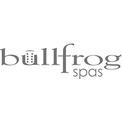
Hot tub prices range from around $5,000 to $15,000. Shells are acrylic-backed with ABS plastic and Isotec rigidizer. Select from five Eterna-Wood color options.
Compare Top Hot Tub Reviews | ||||||
|---|---|---|---|---|---|---|
Offers a variety of spas and spa accessories. Features patented jet technology and energy-efficient full foam insulation. Smartphone app lets you control temperature. Warranties vary by model. Prices start around $5,000. | Chat with a ConsumerAffairs decision guide Live agent | |||||
Features hot tubs with traditional, hydromassage and directional water jets. Insulated with multidensity closed-cell foam. Offers saltwater systems. Includes seven-year structural warranty. Prices start around $3,000. |  | Chat with a ConsumerAffairs decision guide Live agent | ||||
Customizable hot tubs and spas. Energy-efficient systems and JetPak therapy. Discount programs and financing options available. Warranties included. Showrooms across the United States. |  | Chat with a ConsumerAffairs decision guide Live agent | ||||
Sells saunas, hot tubs and accessories. Carries hot tub supplies and custom hot tub covers. Shop inventory by brand or by need. Detailed care and maintenance resources on the website. Free shipping on all orders. |  | Chat with a ConsumerAffairs decision guide Live agent | ||||
Information in this guide is general in nature and is intended for informational purposes only; it is not legal, health, investment or tax advice. ConsumerAffairs.com makes no representation as to the accuracy of the information provided and assumes no liability for any damages or loss arising from its use.
Want your company to be on this guide?
Yes, continueYou’re signed up
We’ll start sending you the news you need delivered straight to you. We value your privacy. Unsubscribe easily.
